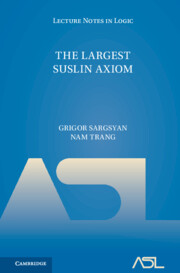Refine search
Actions for selected content:
10 results
Chapter 7 - Analysis of HOD
-
- Book:
- The Largest Suslin Axiom
- Published online:
- 07 June 2024
- Print publication:
- 27 June 2024, pp 207-212
-
- Chapter
- Export citation
Chapter 1 - Introduction
-
- Book:
- The Largest Suslin Axiom
- Published online:
- 07 June 2024
- Print publication:
- 27 June 2024, pp 1-8
-
- Chapter
- Export citation

The Largest Suslin Axiom
-
- Published online:
- 07 June 2024
- Print publication:
- 27 June 2024
 $\operatorname {HOD}$ IN INNER MODELS WITH WOODIN CARDINALS
$\operatorname {HOD}$ IN INNER MODELS WITH WOODIN CARDINALS
- Part of
-
- Journal:
- The Journal of Symbolic Logic / Volume 86 / Issue 3 / September 2021
- Published online by Cambridge University Press:
- 13 August 2021, pp. 871-896
- Print publication:
- September 2021
-
- Article
-
- You have access
- Open access
- HTML
- Export citation
LARGE CARDINALS BEYOND CHOICE
-
- Journal:
- Bulletin of Symbolic Logic / Volume 25 / Issue 3 / September 2019
- Published online by Cambridge University Press:
- 20 August 2019, pp. 283-318
- Print publication:
- September 2019
-
- Article
- Export citation
SOME APPLICATIONS OF SUPERCOMPACT EXTENDER BASED FORCINGS TO HOD
-
- Journal:
- The Journal of Symbolic Logic / Volume 83 / Issue 2 / June 2018
- Published online by Cambridge University Press:
- 01 August 2018, pp. 461-476
- Print publication:
- June 2018
-
- Article
- Export citation
HOD, V AND THE GCH
-
- Journal:
- The Journal of Symbolic Logic / Volume 82 / Issue 1 / March 2017
- Published online by Cambridge University Press:
- 21 March 2017, pp. 224-246
- Print publication:
- March 2017
-
- Article
- Export citation
STRUCTURE THEORY OF L(ℝ, μ) AND ITS APPLICATIONS
-
- Journal:
- The Journal of Symbolic Logic / Volume 80 / Issue 1 / March 2015
- Published online by Cambridge University Press:
- 13 March 2015, pp. 29-55
- Print publication:
- March 2015
-
- Article
- Export citation
LARGE CARDINALS AND LIGHTFACE DEFINABLE WELL-ORDERS, WITHOUT THE GCH
-
- Journal:
- The Journal of Symbolic Logic / Volume 80 / Issue 1 / March 2015
- Published online by Cambridge University Press:
- 13 March 2015, pp. 251-284
- Print publication:
- March 2015
-
- Article
- Export citation
DETERMINACY AND JÓNSSON CARDINALS IN L(ℝ)
-
- Journal:
- The Journal of Symbolic Logic / Volume 79 / Issue 4 / December 2014
- Published online by Cambridge University Press:
- 12 December 2014, pp. 1184-1198
- Print publication:
- December 2014
-
- Article
- Export citation


















 ” and give some applications. First we show that “ ZFC + there exist
” and give some applications. First we show that “ ZFC + there exist  (or equivalently on
(or equivalently on  in this situation) that has the same consistency strength as “ZFC+ there exist
in this situation) that has the same consistency strength as “ZFC+ there exist 
